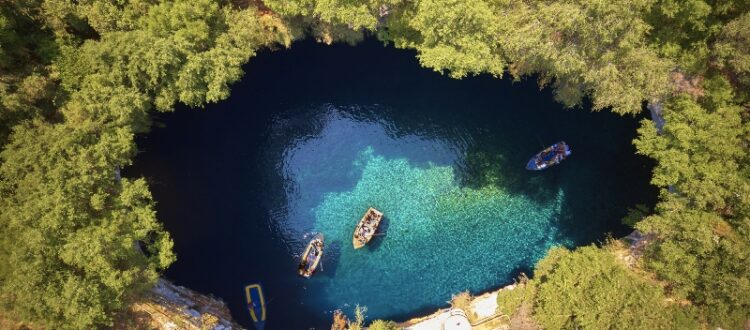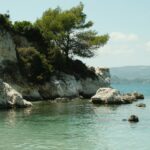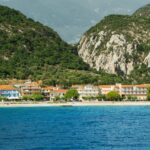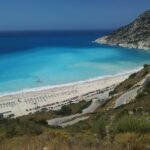Late-summer getaway in Kefalonia
A jewel island that stands out for its colours and the strong contrast between the deep green and the crystal blue, Kefalonia is the pride of the Ionian Sea that thanks to its turbulent history and the “Captain Corelli’s Mandolin” has come to be known all over the world. A natural ecosystem-sanctuary that is home to caretta caretta turtles and, according to many, the mythical homeland of Odysseus, Kefalonia has much to offer to those who really want to get to know it from the beginning and indulge in its own secret magic.
Argostoli
Although it was completely destroyed by Enceladus in 1953, with the photos of the great disaster remaining in the history books, the amphitheatrically built Argostoli is today an active small town of the island province that stands out for the experiences it offers. It goes without saying that a stroll through Lithostroto, the commercial heart of Argostoli, located next to the church of Agios Spyridon, is a must, while the historic Korgialeneios Library with its more than 65,000 books and manuscripts is of huge interest. Also, don’t forget that the folklore museum of Argostoli is located in the same place. Of course, if you have luck on your side, you might catch the local philharmonic orchestra playing traditional Ionian music, while a walk in Argostoli always ends with a romantic stroll on the De Bosset bridge.
Lixouri
Despite the immeasurable destruction caused by the earthquake of ’53 that rewrote the history of Kefalonia from scratch, Lixouri – the second largest urban centre of the island – was rebuilt from the ground up with respect to the traditional Ionian architecture. A calm, relaxed place that associated its name with brilliant literary personalities, Lixouri was the seat of the famous Vallianio Vocational School which, having trained in the post-war years a large number of young people from all over Greece, contributed greatly to the productive reconstruction of post-civil war Greece. Here, the Iakovateios Library, built in 1866, which before the great earthquake of 2014 housed 25,000 volumes of books and valuable ecclesiastical relics from the 10th century, stands out, while a stroll to Kipouria, where you can enjoy one of the most beautiful sunsets in Greece.
Lake Cave of Melissani
If there is one thing that Kefalonia stands out internationally – apart from the filming of the movie “Captain Corelli’s Mandolin” – it is of course the Melissani Lake Cave. Impressive -breathtaking as we would say in a word- the magnificent cave was discovered in 1951 and after a period of updating and inspections, it became fully accessible and open to the public. With the depth of the lake’s waters ranging between 10 and 30 metres, the cavern emerged after a collapse of part of the roof, creating for us today a spectacle of unparalleled natural beauty that only an artist could imagine, and according to expert estimates, the waters of Melissani spill into Agia Euphemia.
Fiskardo
Known as the birthplace of Nikos Kavvadias, Fiskardo with its characteristic name is perhaps one of the few places in Kefalonia that survived the deadly earthquake of ’53. Having taken its name from a persistent Norman conqueror who laid siege to the small fishing village, the idyllic Fiskardo of traditional two-storey houses with small balconies stands out as a premium accommodation option while giving us a good taste of the architecture of pre-quake Kefalonia. A must try is the lobster pasta of Fiskardo, while the fresh fish soaked in the saltiness of the Ionian Sea has never disappointed anyone.
Aenos: Wild nature in the middle of the sea
A unique national park of the Greek islands with the highest peak of Mega Soros at 1,628 meters, Ainos is the birthplace of the Kefalonian fir tree, which gives the mountain this deep brown colour, the right contrast to the deep blue of the island. A mountain unknown to most people in mainland Greece, Aenos is home to several species of wildlife on its slopes, from wild horses to double-breasted horses that stare stubbornly at anyone who disturbs them, thus justifiably attracting the interest of ecologists and tourists sensitive to the conservation of the island’s wildlife.
Assos
Colourful, picturesque and romantic, Assos is not only one of the most beautiful and picturesque villages of Kefalonia, but also of the whole of Greece. A real attraction for visitors and a point of reference for the locals who consider it a true jewel for their place, Assosos, which was flattened in the earthquake of ’53, stands out for its cute houses overlooking the deep blue of the Ionian Sea, carrying on its slopes the turbulent history of Kefalonia.
Kourkoumelata
It would not be an exaggeration to say that this small village in Kefalonian is one of the most beautiful in Europe. A little bit of the landscape with the alternation of green and blue, a little bit of the unique aesthetics and layout of the village full of flowers is enough to make someone want to visit the Kefalonian village, once they set foot on the island. Having been completely destroyed in the earthquake of ’53, the village was rebuilt after a donation from the Vergotis family based on the town plan of Swiss villages. Today, Kourkoumelata is an impressive village-site almost 10 km from Argostoli.
Source: https://www.travel.gr/experiences/late-summer-apodrasi-stin-kefalonia/





